- You are here:
- Home »
- author newsletter
Tag Archives for " author newsletter "

Digital Marketing for Writers: Grow and Sell More Books
Nearly 70% of self-published authors struggle to reach their ideal readers and grow book sales effectively. Without a clear marketing plan, even the best writing can go unnoticed. Understanding practical strategies for defining your audience, building an author platform, and using smart tools can help transform your book’s visibility and sales results.
Table of Contents
- Step 1: Define Your Target Audience And Author Goals
- Step 2: Build A Professional Author Platform
- Step 3: Craft Compelling Email Marketing Campaigns
- Step 4: Leverage Ai Tools To Boost Visibility
- Step 5: Automate Book Sales And Optimize Results
Quick Summary
| Key Point | Explanation |
|---|---|
| 1. Define your audience meticulously | Understand demographics and psychological traits to effectively target your book’s readers. |
| 2. Build a cohesive author platform | Create a professional website, active blog, and social media presence to connect with readers. |
| 3. Craft personalized email marketing | Segment your email list and create engaging content to convert casual readers into loyal fans. |
| 4. Leverage AI tools for efficiency | Use AI to automate tasks like content generation and ad optimization, freeing up your time for writing. |
| 5. Automate marketing processes | Set up automated systems for advertising and email marketing that work continuously without manual input. |
Step 1: Define your target audience and author goals
Successful book marketing starts with crystal clear understanding of who will read your book and what you want to achieve. This foundational step determines every subsequent marketing strategy you will develop.
Begin by creating a detailed reader persona that goes beyond basic demographics. According to research from digital marketing experts, effective audience targeting requires understanding not just age and location but deeper psychological characteristics like reading habits, interests, and pain points.
Ask yourself specific questions about your ideal reader: What motivates them to pick up a book like yours? What problems are they trying to solve? What emotional experience are they seeking? For instance, a romance novelist might target professional women aged 30-45 who want escapist literature after stressful workdays.
Align your specific author goals with your audience research. Are you aiming to:
- Build a loyal reader community
- Generate consistent book sales
- Establish yourself as an authority in your genre
- Create a sustainable author income stream
- Expand your readership internationally
Research indicates that authors who precisely define both audience and objectives are 67% more likely to create targeted marketing campaigns that actually work.
Pro Tip: Update your reader persona every six months as your writing career evolves and you gain more insights about your audience.
Next, you will map out a strategic marketing approach that speaks directly to your carefully defined reader persona.
Step 2: Build a professional author platform
Your author platform is your digital home base where readers discover and connect with your writing. It transforms you from an unknown writer to a recognized brand with consistent online presence.
According to digital marketing research from Elsevier’s marketing strategies guide, an effective author platform integrates multiple digital touchpoints to maximize audience reach. This means creating a cohesive online ecosystem that tells your unique storytelling narrative.
Start by establishing these core digital assets:
Here’s a comparison of the core elements of a professional author platform:
| Element | Purpose | Key Tips |
|---|---|---|
| Author Website | Main information hub | Clean design Clear branding |
| Blog | Showcases expertise and updates | Consistent posts Engage readers |
| Social Media Profiles | Builds community and discoverability | Focus on top 2-3 platforms |
| Email Newsletter | Direct reader connection and updates | Value-first Personal approach |
- Professional author website showcasing your books and biography
- Active blog demonstrating your writing expertise
- Consistent social media profiles on platforms where your target readers spend time
- Email newsletter for direct reader communication
Your website serves as the central hub. Make it clean, professional, and reflective of your writing genre. Include high quality author photos, book descriptions, purchase links, and ways for readers to connect with you.

Social media allows you to build personal connections. Choose 2-3 platforms where your ideal readers congregate. For fiction writers, this might mean Instagram and TikTok. For nonfiction authors, LinkedIn and Twitter could be more strategic.
Pro Tip: Consistency matters more than perfection. Regular small updates beat sporadic grand gestures.
Growing an author platform requires patience and strategic effort. Your next step involves creating compelling content that attracts and retains your ideal readers.
Step 3: Craft compelling email marketing campaigns
Email marketing transforms casual readers into loyal fans and consistent book buyers. Your goal is creating magnetic email sequences that readers actually want to open and engage with.
According to research from Automateed’s book marketing guide, successful email campaigns rely on personalized sequences that nurture readers through strategic touchpoints. This means designing emails that feel like personal conversations rather than generic broadcasts.
Start by segmenting your email list based on reader interests and behaviors. Fiction writers might create different tracks for romance versus thriller fans. Nonfiction authors could segment by professional interests or reading preferences.
Your email sequence should include:
- Welcome email introducing yourself and your writing
- Engagement emails sharing behind the scenes content- Promotional emails highlighting new book releases
- Value driven content that entertains or educates
Pay special attention to your subject lines. They are your first and sometimes only chance to capture a reader’s attention. Make them intriguing personal and specific to your reader’s interests.
As Automateed’s author email marketing research demonstrates, converting subscribers requires offering exclusive benefits. Think about providing special reader rewards like chapter previews bonus content or limited time discounts.
Pro Tip: Aim for an 80/20 balance. Spend 80% of your emails providing value and only 20% directly selling.
Effective email campaigns are an art form that develops with practice. Your next step involves analyzing your email performance and continuously refining your approach.
Step 4: Leverage AI tools to boost visibility
AI technology has transformed book marketing from a time consuming process to a strategic powerhouse. Your goal is using intelligent tools that amplify your reach while saving precious writing time.
According to Manuscript Report’s comprehensive AI publishing guide, AI can automate multiple visibility boosting tasks across different marketing channels. This means generating social media content email sequences and optimizing advertising with unprecedented precision.
Start exploring AI tools in these key areas:
- Social media content generation
- Email marketing optimization
- Amazon ad targeting
- Book description refinement
- Reader targeting analysis
For social media marketing AI can help draft engaging posts that sound authentically like your writing voice. These tools analyze your previous content and generate posts that match your style and resonate with your target audience.
In email marketing AI becomes your strategic partner. As Anyword’s marketing platform demonstrates, intelligent systems can generate email subject lines optimize send times and predict which messaging will most likely convert readers into book buyers.
When it comes to advertising AI tools can analyze complex data points to identify your most promising reader demographics. This means smarter ad spending and higher conversion rates.
Pro Tip: Always review and personalize AI generated content. The tool provides the framework but your unique voice makes it compelling.
AI book marketing represents the future of author promotion. Your next step involves experimenting with these tools and measuring their impact on your book sales and reader engagement.
Step 5: Automate book sales and optimize results
Automation transforms book marketing from a manual grind into a strategic growth engine. Your mission is creating systems that sell books while you focus on writing.
According to Automateed’s book marketing automation guide, successful automation requires setting up intelligent advertising platforms that monitor and adjust campaigns in real time. This means creating systems that work continuously without constant manual intervention.
Key automation strategies include:
- Setting up perpetual Amazon advertising campaigns
- Creating evergreen email marketing sequences
- Implementing retargeting ads for website visitors
- Developing automated social media content schedules
- Building reader acquisition funnels
Amazon advertising presents a prime opportunity for automation. Manuscript Report’s AI publishing analysis reveals that intelligent bid adjustment tools can dramatically reduce advertising costs while maintaining strong visibility.
Your email marketing should function like a silent sales team. Design sequences that automatically welcome new subscribers trigger follow up messages based on reader interactions and recommend books without constant oversight.
Track your key performance indicators religiously. Watch metrics like cost per click conversion rates and return on ad spend. These numbers tell you exactly how your automated systems perform.
Pro Tip: Review your automation systems monthly. Small tweaks can generate significant performance improvements.
Book sales funnel optimization is an ongoing process. Your next step involves continuously refining these automated systems to maximize your book sales potential.

Unlock Your Full Book Marketing Potential Today
If you’ve ever felt overwhelmed trying to connect with your ideal readers or struggled to turn casual interest into loyal fans, you are not alone. This article highlights the importance of defining your target audience, building a professional author platform, crafting magnetic email marketing, and harnessing AI tools to automate and amplify your book sales. These challenges often leave writers searching for clear, proven systems that can actually deliver results.
At DigitalMarketingAuthors.com, we understand these exact struggles and the critical goals you want to achieve: growing a dedicated reader community, automating sales, and scaling your author brand without wasting precious time or resources. Founded by 13x #1 Amazon bestselling author C.T. Mitchell, our platform offers step-by-step strategies and AI-powered solutions that turn ambitious marketing plans into consistent book sales and broader visibility.
Ready to stop guessing and start growing

Discover how to build your professional author platform and craft compelling email campaigns that truly resonate. Take control of your marketing journey right now and visit Digital Marketing Authors to access expert guidance and tools tailored for indie authors who want to market smarter, sell faster, and scale worldwide. Your next bestselling chapter begins with the right marketing system.
Frequently Asked Questions
How can I define my target audience for effective book marketing?
To define your target audience, create a detailed reader persona that includes not just demographics, but also psychological factors like interests and pain points. Start by asking specific questions about what motivates your ideal reader, what problems they want to solve, and what emotional connection they seek from your book.
What are the essential elements of a professional author platform?
A professional author platform should include a user-friendly website, an active blog, social media profiles, and an email newsletter. Focus on creating a cohesive online presence that reflects your genre and allows you to connect with readers effectively.
How should I structure my email marketing campaigns to engage readers?
Structure your email marketing campaigns around personalized sequences that nurture your readers. Include a warm welcome email, engaging content that offers behind-the-scenes glimpses, and promotional emails that announce new releases; aim for an 80/20 balance, providing value in 80% of your emails and selling in 20%.
What AI tools can I use to enhance my book marketing efforts?
Explore AI tools that can assist with generating social media content, optimizing email marketing, and refining book descriptions. Start using these tools to automate repetitive tasks, which can save you time and increase your promotional reach.
How can I automate my book sales to maximize results?
Automate your book sales by setting up continual advertising campaigns, creating evergreen email sequences, and implementing retargeting ads for website visitors. Review your automation processes monthly to identify areas for improvement and boost sales performance by about 20%.
Recommended

Book Preorder Strategies Explained: Complete Guide
Did you know that authors who use preorders can see up to 30 percent more sales during their book’s launch week? Preorder campaigns are quickly becoming a favorite strategy because they help writers build excitement, measure interest, and earn revenue before release day. By learning how effective preorders work, authors can improve their book’s visibility and connect with readers months before the first copy ships.
Table of Contents
- Defining Book Preorders And Their Benefits
- Types Of Preorder Campaigns For Authors
- Step-By-Step Process For Preorder Success
- Leveraging Email, Social, And AI Tools
- Risks, Costs, And Common Preorder Mistakes
Key Takeaways
| Point | Details |
|---|---|
| Strategic Preorders | Book preorders help authors generate early sales, create buzz, and improve visibility on platforms like Amazon. |
| Campaign Types | Authors can utilize various campaign types including direct platform preorders and social media blitzes to maximize engagement. |
| Marketing Execution | Effective preorder strategies rely on compelling metadata, exclusive incentives, and a multi-channel marketing approach. |
| Avoiding Pitfalls | Common mistakes such as poor timing and inadequate audience targeting can undermine preorder success; authors should navigate these risks carefully. |
Defining Book Preorders and Their Benefits
A book preorder represents a strategic marketing approach where readers can purchase and reserve a book before its official release date. This powerful technique allows authors to generate excitement, build anticipation, and secure advanced sales that can significantly impact initial book rankings and visibility.
Book preorders offer multiple strategic advantages for authors. According to the University of California Press, effective preorder campaigns leverage critical metadata like precise publication dates, compelling book descriptions, and targeted keywords to optimize online discoverability. These advanced sales not only help authors gauge reader interest but also provide crucial momentum for launch week performance.
Key benefits of book preorders include:
- Generating early revenue before official publication
- Creating buzz and anticipation around your upcoming release
- Potentially improving initial book rankings on platforms like Amazon
- Providing authors with early sales data and reader engagement metrics
- Allowing readers to secure their copy in advance of the official launch
For independent authors, preorders represent more than just a sales strategy. They are a powerful tool for building reader engagement and creating a sense of community around your upcoming book. Book launch strategies can be significantly enhanced by implementing a well-planned preorder campaign that connects directly with your target audience.
Types of Preorder Campaigns for Authors
Authors can leverage several strategic preorder campaign types to maximize book visibility and reader engagement. These campaigns range from direct platform-based approaches to more complex multi-channel marketing strategies designed to build anticipation and drive early sales.
According to the Self-Publishing Advice Center, independent authors have multiple promotional avenues to explore. Platform-exclusive preorders typically involve focusing on specific retail channels like Amazon KDP, where authors can offer early purchase options with special incentives. These campaigns often include limited-time pricing, exclusive bonus content, or signed edition opportunities to entice early buyers.
Key preorder campaign strategies include:
Here’s a comparison of popular preorder campaign types for authors:
| Campaign Type | Key Features | Best For |
|---|---|---|
| Direct Platform Preorders | Platform exclusivity Easy setup |
Wide reach Amazon focus |
| Email List Campaigns | Personalized offers Direct connection |
Engaged audiences |
| Social Media Preorder Blitz | Viral potential Short-term buzz |
Brand building |
| Influencer Partnership | Third-party endorsement Wider exposure |
Niche audiences |
| Early Bird Discount Campaign | Limited-time pricing Urgency creation |
Value-driven readers |
- Direct Platform Preorders: Using Amazon, Barnes & Noble, and other book retailer platforms
- Email List Campaigns: Targeting existing readers with exclusive preorder opportunities
- Social Media Preorder Blitz: Creating time-limited promotional events across digital channels
- Influencer Partnership Preorders: Collaborating with book reviewers and content creators
- Early Bird Discount Campaigns: Offering reduced pricing for readers who preorder early
For authors seeking comprehensive marketing approaches, book marketing strategies for authors can provide additional insights into creating successful preorder campaigns that connect meaningfully with your target audience and drive initial book sales.

Step-by-Step Process for Preorder Success
Successful book preorder campaigns require meticulous planning and strategic execution. Authors must approach their preorder strategy as a comprehensive marketing journey that begins months before the actual book launch, carefully crafting each stage to maximize reader engagement and potential sales.
According to the University of California Press, the foundation of any successful preorder campaign starts with compelling metadata. This includes creating an attention-grabbing book description, selecting strategic keywords, and ensuring all publication details are accurate and enticing. Research indicates that authors who invest time in developing high-quality metadata significantly improve their book’s online discoverability and potential for early sales.
The comprehensive preorder process typically involves these critical steps:
- Develop Compelling Book Metadata: Create an irresistible book description
- Build Anticipation: Start promoting 3-6 months before release date
- Create Exclusive Preorder Incentives: Design special bonuses for early buyers
- Leverage Multiple Marketing Channels: Utilize email, social media, and author networks
- Track and Adjust: Monitor preorder performance and adapt strategies
Independent authors looking to refine their marketing approach can find additional insights through bestselling author strategy resources that provide advanced techniques for turning preorder campaigns into powerful book launch mechanisms.
Leveraging Email, Social, and AI Tools
Modern book preorder strategies demand a sophisticated approach that integrates digital marketing channels with cutting-edge technological tools. Authors now have unprecedented opportunities to connect with readers and create targeted, personalized promotional campaigns that extend far beyond traditional marketing methods.
According to the University of California Press’s promotional toolkit, effective author marketing requires a multi-channel strategy that seamlessly combines email outreach, social media engagement, and emerging AI technologies. Email marketing remains a powerful tool, allowing authors to develop direct relationships with readers by creating segmented lists, crafting personalized preorder communications, and designing automated follow-up sequences that build anticipation for upcoming book releases.
Key strategies for leveraging digital tools include:
- Targeted Email Campaigns: Segment reader lists and create personalized preorder invitations
- Social Media Countdown: Use platforms like Instagram and Twitter to build excitement
- AI-Powered Content Creation: Generate engaging promotional materials and social media posts
- Automated Marketing Sequences: Design multi-step communication strategies
- Performance Tracking: Use analytics to refine and optimize preorder approaches
Authors looking to stay ahead of the marketing curve can explore AI strategies for book marketing to unlock advanced techniques for transforming their preorder campaigns into highly effective reader engagement mechanisms.
Risks, Costs, and Common Preorder Mistakes
Book preorder campaigns, while powerful, come with potential pitfalls that can derail an author’s marketing strategy. Understanding these risks is crucial for developing a robust and successful preorder approach that minimizes financial exposure and maximizes reader engagement.
According to the Self-Publishing Advice Center, authors must carefully navigate the financial and strategic risks associated with promotional programs. Platform exclusivity can be a significant constraint, particularly with programs like KDP Select, which may limit an author’s ability to distribute their book across multiple sales channels. The University of California Press warns that neglecting critical elements like metadata optimization can severely impact a book’s online discoverability and potential preorder success.
Common preorder mistakes authors should avoid include:
- Insufficient Metadata Preparation: Incomplete or poorly crafted book descriptions
- Unrealistic Pricing Strategies: Setting prices too high or offering inconsistent discounts
- Lack of Audience Targeting: Failing to identify and reach the right reader demographic
- Poor Timing: Starting preorder campaigns too early or too late
- Inadequate Marketing Follow-through: Not maintaining consistent promotional momentum
Independent authors seeking to mitigate risks and optimize their marketing approach can find valuable guidance through book marketing strategies for authors, which provide comprehensive insights into avoiding common preorder campaign pitfalls.
Unlock the Full Potential of Your Book Preorder Campaigns
If you are struggling with building buzz, optimizing metadata, or creating engaging preorder incentives you are not alone. Many authors find it challenging to navigate the complexities of preorder strategies such as email list segmentation, AI-powered content creation, and managing multi-channel marketing efforts. The pain of launching without a strong preorder plan can lead to missed sales and lost momentum.
At DigitalMarketingAuthors.com, founded by 13x #1 Amazon bestselling author C.T. Mitchell, we understand these challenges and offer proven systems designed to help you market smarter and sell faster. Whether you want to craft magnetic email sequences, leverage AI tools for effective promotions, or build a loyal reader community that drives demand before your book’s release, we provide step-by-step support tailored to your goals.

Ready to stop guessing and start growing your preorder success? Visit DigitalMarketingAuthors.com today to explore powerful book marketing strategies for authors and bestselling author strategy resources. Take control of your book launch and watch your preorder sales soar.
Frequently Asked Questions
What are the main benefits of book preorders for authors?
Book preorders help authors generate early revenue, create buzz around their release, improve initial book rankings, provide early sales data, and allow readers to secure their copy ahead of launch.
What types of preorder campaigns can authors implement?
Authors can use various preorder campaign types, including direct platform preorders, email list campaigns, social media preorder blitzes, influencer partnerships, and early bird discount campaigns to maximize visibility and engagement.
What are the critical steps for a successful preorder campaign?
A successful preorder campaign involves developing compelling book metadata, building anticipation leading up to the release, creating exclusive incentives for early buyers, leveraging multiple marketing channels, and tracking performance to adjust strategies as needed.
What common mistakes should authors avoid when setting up preorder campaigns?
Authors should avoid mistakes such as insufficient preparation of metadata, unrealistic pricing strategies, lack of audience targeting, poor timing in campaign launches, and inadequate follow-through in marketing efforts.
Recommended
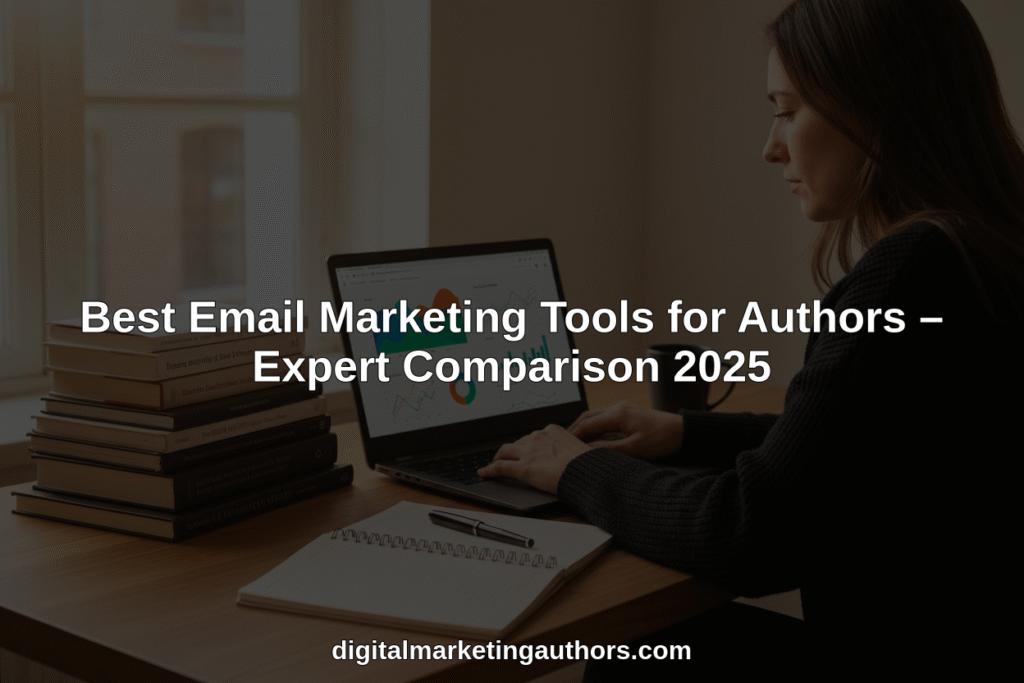
Best Email Marketing Tools for Authors – Expert Comparison 2025
Every writer looking to share their work faces the challenge of reaching readers and staying ahead of changing trends. There are many ways to grow an audience, build lasting relationships, or get real help with writing and publishing goals.
Some people prefer simple tools for sending emails or running promotions.
Others want expert advice, a supportive community, or new ways to connect with fans. The different options can feel overwhelming but each one brings its own style and practical benefits. Curious about which approach might fit your journey best?
Table of Contents
Digital Marketing Authors
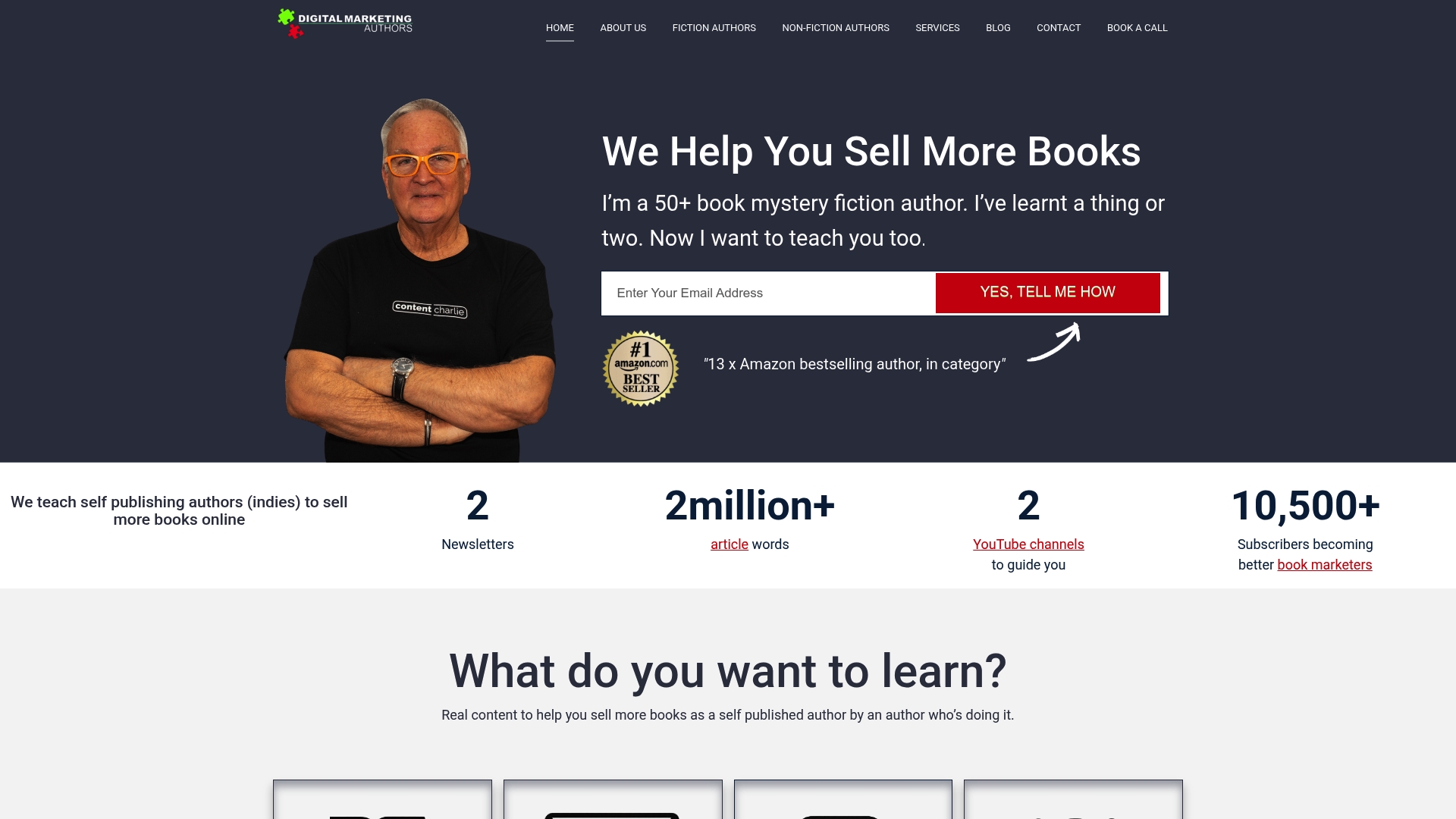
At a Glance
Digital Marketing Authors is a practical, author-focused resource that helps self-published writers sell more books using clear marketing methods.
Founded and led by Greg Reed, the site emphasizes email marketing, social media, and emerging AI tactics tailored for indie authors.
If you want straightforward strategies to grow a reader list and automate sales without relying on traditional publishers, this site gives actionable direction and inspiration.
Core Features
Digital Marketing Authors bundles concise, experience-driven guidance on email marketing, social media marketing, and AI marketing specifically for authors. The site teaches how to build a loyal reader community (a “reader army”), craft newsletter content that converts, and reinforce reader trust through consistent communication. Content formats include how-to articles, publishing tips, and strategic insights drawn from Greg Reed’s background as an author and marketing specialist. Note the site leans toward strategy and big-picture frameworks rather than step-by-step software tutorials or price-comparison guides, which is a deliberate focus on mindset and campaign design over product sales.
Pros
- Practical, experience-based advice: The guidance is grounded in real author experience, which means recommendations are relatable and immediately usable by working writers.
- Designed for self-publishing authors: Every tactic targets indie authors’ needs, from list-building to low-cost promotions, so you won’t waste time on irrelevant corporate marketing fluff.
- Includes modern AI marketing strategies: The site covers up-to-date approaches that help authors save time and scale outreach when used responsibly.
- Strong focus on reader trust and engagement: Emphasis on relationship-building helps authors turn casual readers into repeat buyers and long-term fans.
Who It’s For
This resource is ideal for self-published and indie authors who want to take control of their marketing. If you’re an author building your first newsletter, scaling a modest backlist, or trying to convert social followers into buyers, the site gives clear strategic direction. It’s especially useful for authors who prefer learning tactics and workflows rather than buying a single plug-and-play platform.
Unique Value Proposition
Digital Marketing Authors stands out because it translates book marketing into author-friendly tactics that actually map to publishing goals: more signups, stronger reader loyalty, and repeat sales. Unlike generic marketing blogs, every recommendation ties back to book discovery and purchase behavior. The combination of email-first thinking, social amplification, and pragmatic AI use creates a cohesive path from audience building to consistent revenue — a major advantage for independent writers who need repeatable, low-cost systems rather than one-off hacks.
Real World Use Case
An indie novelist follows the site’s newsletter templates and list-growth tips, then combines scheduled social posts with targeted email sequences. Over a few months, the author grows a mailing list, primes readers with trust-building content, and launches a discounted backlist promotion that yields measurable spikes in book sales and reviews.
Pricing
Not specified on the website.
Website: https://digitalmarketingauthors.com
MailerLite
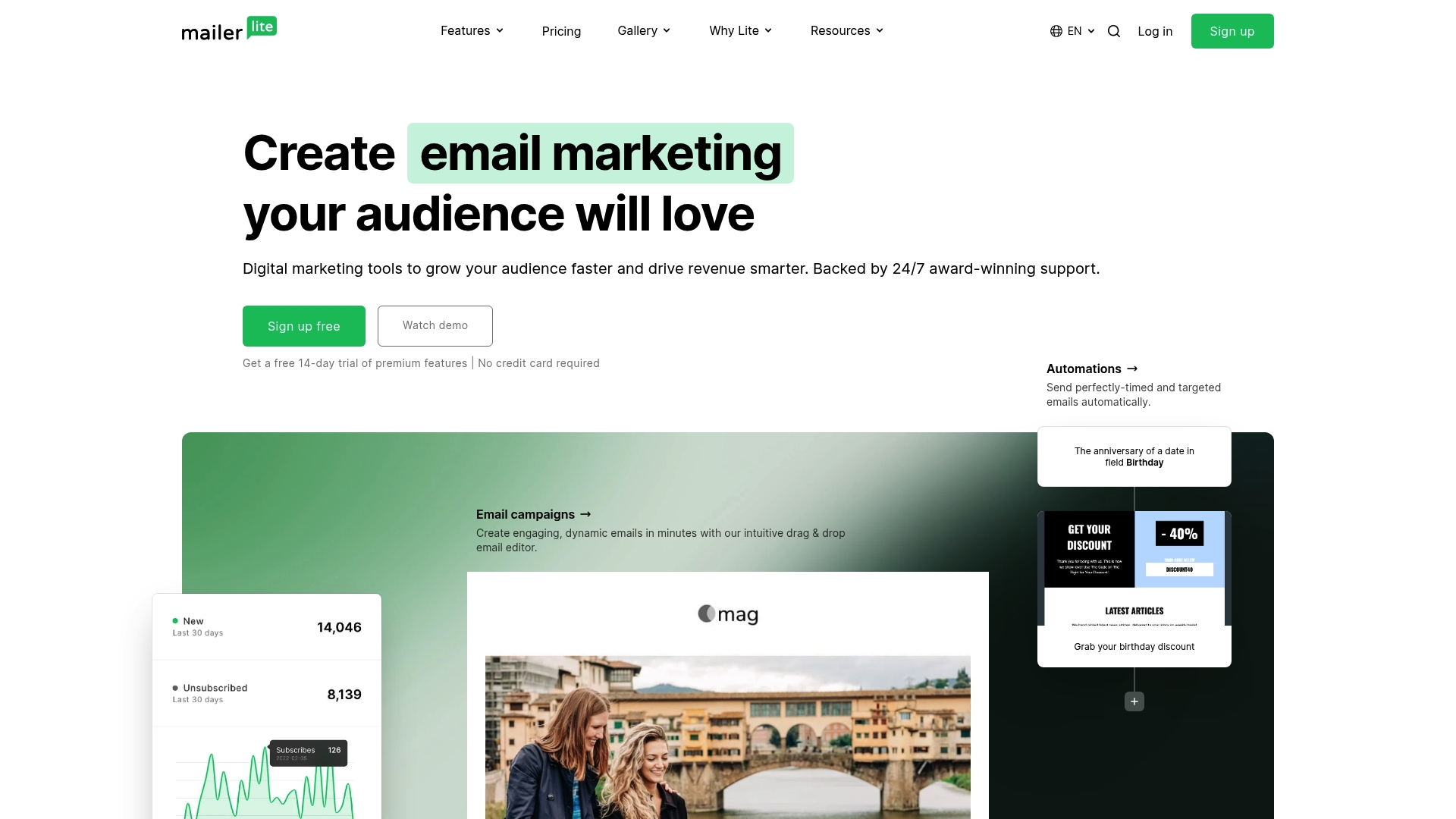
At a Glance
MailerLite is a clean, approachable email marketing platform built for creators, small businesses, and indie authors who want powerful features without the clutter. Its drag-and-drop editor, landing page builder, and automation tools make it easy to launch campaigns and grow a list quickly. The free tier (up to 500 subscribers) and attentive support lower the barrier for authors starting out. Expect limitations on advanced automation and subscriber caps unless you move to a paid plan.
Core Features
MailerLite combines core email marketing capabilities with website-building tools so you can run campaigns from a single dashboard. You get a drag-and-drop email editor, automations for targeted sequences, templates for emails and landing pages, signup forms and pop-ups, and tools to sell digital products and manage subscriptions. The platform also includes integrations with common web apps like Shopify and WooCommerce, A/B split testing, personalization options, and advanced analytics and reporting to track campaign performance.
Pros
- User-friendly interface: The platform’s simple, beautiful UI helps you build campaigns quickly without a steep learning curve.
- Robust automation and segmentation: MailerLite provides automation workflows and segmentation tools that let you send targeted, timely emails to different reader groups.
- Flexible plans including a free tier: You can start for free with up to 500 subscribers, which is ideal for authors testing email marketing before committing.
- Excellent customer support: The service is known for attentive support, which is helpful when you’re setting up automations or troubleshooting deliverability.
- Wide range of integrations and templates: Ready-made templates and integrations with e-commerce platforms simplify selling books or digital products directly from campaigns.
Cons
- Limited automation steps in lower-tier plans: Lower-cost plans restrict the number of automation steps available, which can hamper more complex author funnels.
- Advanced features require paid plans: Several advanced capabilities and higher subscriber limits are gated behind paid tiers, so you may outgrow the free plan quickly.
- Subscriber limit can cause automatic tier upgrades when exceeded: If your list grows past plan limits, MailerLite can trigger an automatic upgrade, which may lead to unexpected costs.
Who It’s For
MailerLite is ideal for indie authors, self-published writers, and small-to-medium creators who want a straightforward platform to build a reader list, run promotional campaigns, and sell digital products without hiring technical help. If you value ease-of-use, built-in landing pages, and a friendly support team, MailerLite fits well.
Unique Value Proposition
MailerLite’s strength is combining a clean, beginner-friendly interface with enough advanced features—like automations, landing pages, and product selling—to serve authors as they scale. The free entry point and variety of templates help you get campaigns live fast while integrations let you connect sales channels as your audience grows.
Real World Use Case
A small ecommerce store (or an indie author selling ebooks) uses MailerLite to run promotional campaigns, automate welcome and post-purchase emails, and grow its subscriber base via signup forms and landing pages—turning casual readers into repeat buyers.
Pricing
Starting at free (up to 500 subscribers); paid plans from $10/month for larger lists and more features.
Website: https://mailerlite.com
ConvertKit
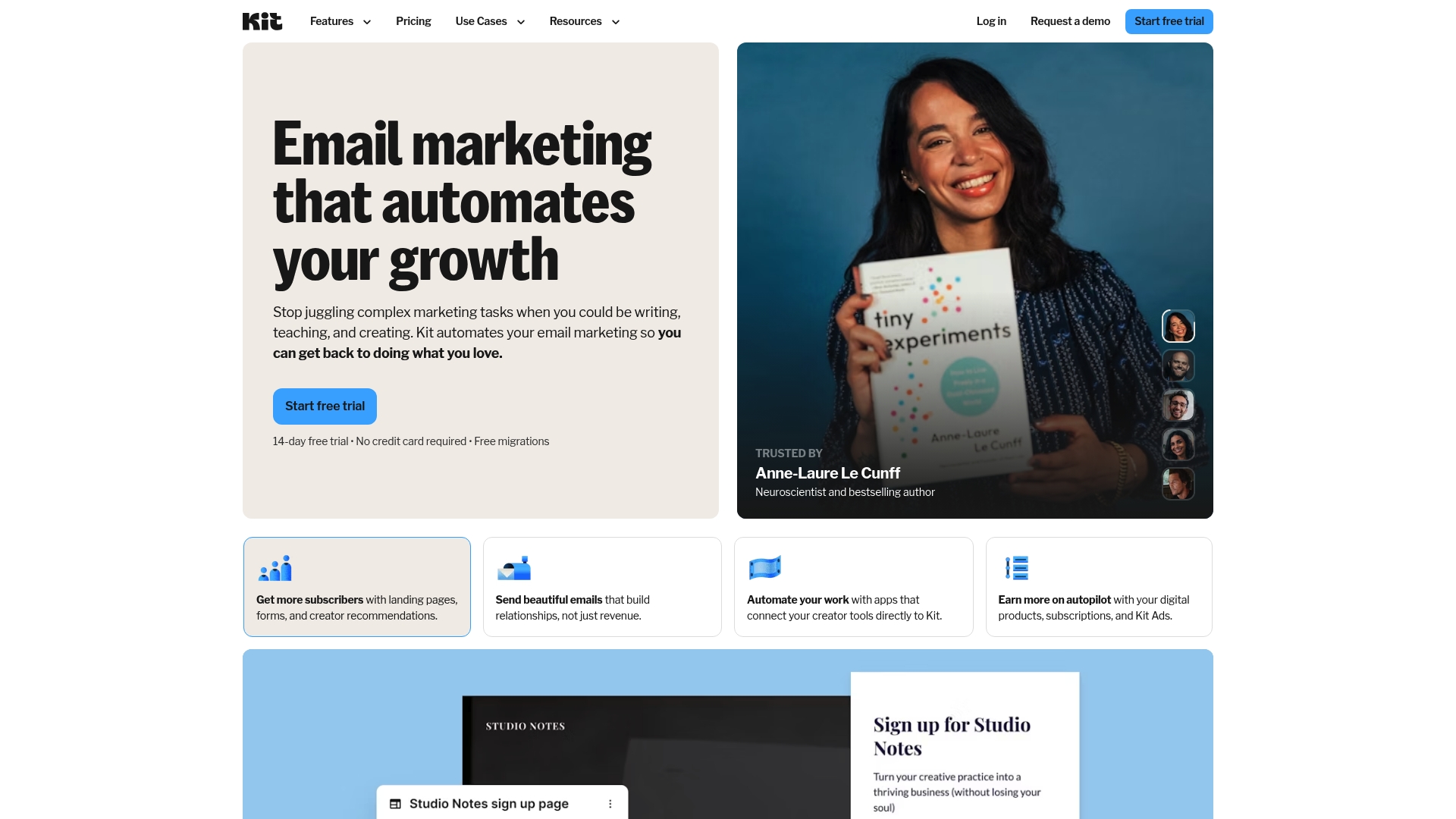
At a Glance
ConvertKit is an email marketing platform built for creators, authors, and small teams who want a straightforward way to grow audiences, automate outreach, and sell digital products or subscriptions. It combines landing pages, forms, tagging, and visual automations in a single interface that’s easy to pick up. If you want reliable deliverability and creator-focused monetization tools without a steep learning curve, ConvertKit is a strong, practical choice. It’s not the most customizable enterprise solution, but it gives most creators exactly what they need to build and monetize an audience.
Core Features
ConvertKit includes unlimited landing pages, forms, and email broadcasts, plus audience tagging and segmentation to organize readers. Its visual automation and email sequence builder make it simple to map onboarding and nurture flows. You can create landing pages and basic websites inside the platform and personalize messages using Liquid-style dynamic content for targeted messaging. The package is intentionally integrated so authors can switch between list growth, automation, and selling without stitching multiple tools together.
Pros
- Easy-to-use interface tailored for creators: The platform keeps common tasks simple, so you can focus on writing and audience-building rather than tool setup.
- Includes landing pages, forms, and automation tools in one platform: You won’t need separate tools to capture emails, build sequences, and host basic landing pages.
- High email deliverability rate (99.8%): Your messages are more likely to reach readers’ inboxes, which matters when every launch email counts.
- Provides free migration from other platforms: Moving your list in is less painful, helping you avoid migration friction when switching systems.
- Flexible pricing plans suitable for different sizes of creator businesses: There’s a free tier and graduated paid plans so you can scale as your list grows.
Cons
- Limited customizability compared to some larger platforms: If you need deep template control or highly specialized email layouts, ConvertKit’s design flexibility can feel constrained.
- Some advanced automation features available only in higher-tier plans: Full automation depth requires upgrading, which may surprise growing creators on a budget.
- Experience with larger or more complex businesses might find limitations in automation depth: Enterprise-level teams may hit feature ceilings as their workflows become more intricate.
Who It’s For
ConvertKit is ideal for creators, authors, educators, and small business owners who want an email tool designed around content and community. If you publish books, run newsletters, sell courses or memberships, and prefer a clean interface with built-in landing pages and monetization, ConvertKit fits well.
Unique Value Proposition
ConvertKit’s unique value is bundling creator-friendly list building, tagging, visual automations, and monetization into one platform with best-in-class deliverability. It emphasizes speed and simplicity so creators can convert attention into revenue without technical overhead.
Real World Use Case
A digital marketing coach used ConvertKit to set up automated onboarding sequences and landing pages, which helped increase their email subscribers by 100,000 through targeted forms and personalized campaigns — demonstrating how ConvertKit scales list growth and nurtures readers into buyers.
Pricing
Starting at Free plan for up to 10,000 subscribers; paid plans start at $33/month for up to 1,000 subscribers (Creator), with higher tiers adding features and subscriber limits.
Website: https://convertkit.com
Reedsy
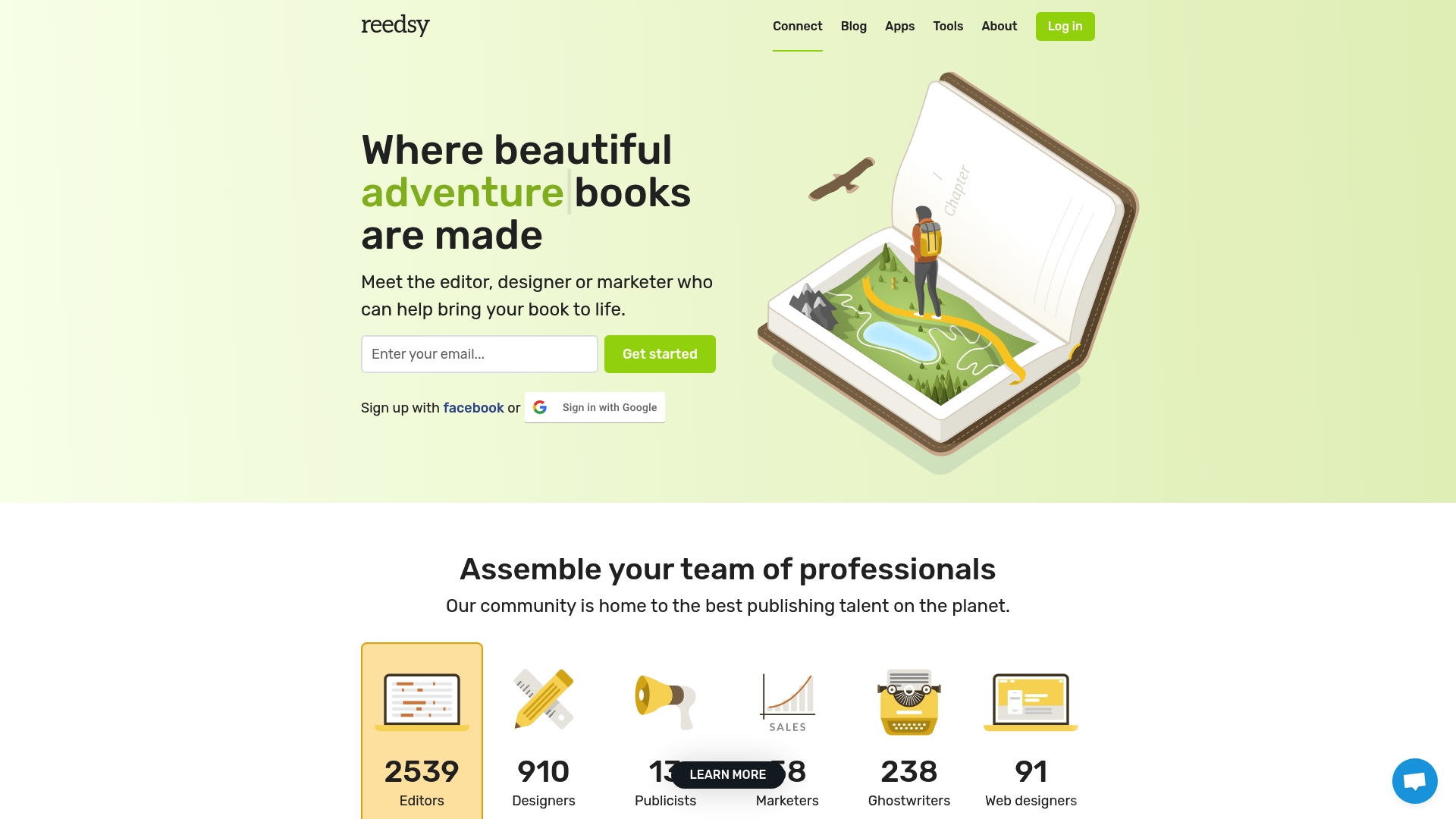
At a Glance
Reedsy is a curated marketplace that connects authors with professional editors, designers, marketers, publicists, and other publishing specialists. It pairs a searchable directory of vetted professionals with basic collaboration and project management tools, plus free educational courses for authors. If you need to hire specialists for specific stages of your book journey, Reedsy makes finding and managing those relationships straightforward — though you should expect to pay per service and verify quality case-by-case.
Core Features
Reedsy’s core strengths are its marketplace and the practical collaboration tools built around it. Authors can browse profiles and portfolios for editors, designers, marketers, and more, request quotes, and manage conversations and files through an integrated messaging and project management interface. The platform also offers free educational courses on writing, self-publishing, and marketing, helping authors level up while they hire professionals. In short: search, hire, and collaborate in one place, with resources to help you make informed choices.
Pros
- Access to a wide network of experienced publishing professionals: Reedsy brings many specialized roles together so you can find editors, cover designers, and marketers without hunting across multiple sites.
- Streamlined collaboration and communication tools: Built-in messaging, file sharing, and basic project management reduce the friction of working with remote freelancers.
- Educational resources for authors: Free courses on writing and publishing help you learn the process and ask smarter questions when hiring.
- Ease of finding and hiring specialists for different stages of publishing: Whether you need copyediting, a cover, or a publicity plan, you can source each role from one marketplace.
- Support for various roles including editing, design, marketing, and more: The breadth of professional categories makes Reedsy useful across an entire publishing timeline.
Cons
- Potential costs associated with hiring professionals and services: Most services are paid per project, which can add up depending on the quality and scope you choose.
- Dependence on the platform’s professional quality, which may vary: While profiles and portfolios help, the level and consistency of work can differ between freelancers.
- Limited information on pricing structures for services: Reedsy doesn’t list standardized prices, so you’ll often need to request quotes and compare proposals to understand total costs.
Who It’s For
Reedsy is ideal for authors at any stage who want professional help but prefer to manage the process themselves. Indie authors, self-publishers, and writers transitioning from traditional publishing will find it especially useful when they need vetted freelancers for discrete tasks like editing, cover design, or book marketing.
Unique Value Proposition
Reedsy combines a specialized marketplace with practical collaboration tools and educational content, making it a one-stop platform for authors who want to hire professionals while staying in control of their projects.
Real World Use Case
An author uploads a manuscript excerpt to browse editors, requests quotes from two promising candidates, hires one for a developmental edit, then contracts a cover designer and a marketing specialist through the same platform to prepare the book for launch.
Pricing
Quote-based: Pricing is not specified on the platform and typically involves paying for professional services requested through Reedsy.
Website: https://reedsy.com
Author Marketing Group™
At a Glance
Author Marketing Group™ is a membership-focused support network designed to help authors expand their reach, increase book sales, and grow their professional influence. It mixes community connection, virtual mastermind sessions, and a curated directory of marketing professionals and resources. If you want collaboration, peer feedback, and access to vetted services in one place, this group delivers a clear membership-oriented framework. However, you should be prepared to ask questions about costs and specific program outcomes before committing, since public details are high level.
Core Features
Author Marketing Group™ centers on three core capabilities: a global community for author-to-author connection and collaboration, virtual mastermind groups that provide structured learning and creative growth, and a curated collection of marketing professionals, services, platforms, and resources exclusive to members. These pieces are positioned to guide authors from idea through publication and into ongoing promotion, combining peer support with professional referral options rather than a single all-in-one software tool.
Pros
- Access to a global community for support and collaboration: Members can connect with authors and supporters worldwide to share feedback, strategies, and encouragement.
- Opportunities for growth through mastermind groups and events: Regular virtual masterminds provide structured spaces for learning, accountability, and creative development.
- Curated marketing resources and services exclusive to members: The group offers a vetted directory of professionals and platforms to help authors find targeted marketing help.
- Focus on helping authors increase impact, influence, and income: The stated mission clearly targets measurable author goals—visibility, sales, and professional growth.
- Potential for networking with professionals and other authors worldwide: The community model facilitates introductions to industry professionals and cross-promotional opportunities.
Cons
- Information provided is promotional and broad, lacking specifics on individual programs or services: The public description emphasizes benefits but does not list concrete curricula, tools, or deliverables.
- Details on costs, membership fees, or commitment are not specified: You cannot determine value or budget impact from the site alone and will need to request pricing.
- No immediate details on the scope or success stories of the group, requiring further inquiry for clarity: The absence of clear case studies or measurable outcomes makes it harder to predict how the group will perform for your specific goals.
Who It’s For
Author Marketing Group™ is best for authors and entrepreneur-authors who want community-driven support rather than a standalone email platform or do-it-yourself marketing course. If you value peer accountability, curated professional referrals, and virtual mastermind learning, this membership model fits. It’s especially useful for authors ready to invest time in networking and to follow through on collaborative marketing efforts.
Unique Value Proposition
The group’s unique offer is its blend of community accountability plus access to a curated marketing ecosystem. Instead of selling tools or single services, it packages connection, learning, and vetted referrals to help authors navigate promotion from concept to market impact.
Real World Use Case
An author joins to attend mastermind calls, receives feedback on a launch plan from peers, and hires a recommended marketing professional from the member directory to run targeted promotions—resulting in clearer strategy and coordinated outreach across channels.
Pricing
Not specified on the website.
Website: https://authormarketinggroup.com
Digital Marketing Tools for Authors Comparison
This table provides a concise summary of various digital marketing tools and resources tailored for authors. Compare features, pros, cons, and pricing to choose the right platform that fits your self-publishing and marketing needs.
| Platform | Key Features | Pros | Cons | Pricing |
|---|---|---|---|---|
| Digital Marketing Authors | Focused on email, social media, and AI strategies for authors | Practical advice, designed for self-publishing, includes AI strategies, reader engagement focus | Strategy over step-by-step guides | Not specified |
| MailerLite | Email marketing platform with drag-and-drop editor, landing pages, automations | User-friendly, robust automation, free plan for up to 500 subscribers, good support | Limited free tier automation, advanced features gated, possible unexpected cost upgrades | Free up to 500 subscribers; $10/mo+ |
| ConvertKit | Email and audience building with landing pages, forms, and automations | Easy to use, high deliverability, free migration, flexible pricing | Limited customization, some features in higher plans | Free up to 10,000 subscribers; $33/mo+ |
| Reedsy | Marketplace for hiring publishing professionals, collaboration tools | Access to publishing experts, streamlined communication, educational resources | Service costs can add up, variability in service quality | Quote-based, pricing unspecified |
| Author Marketing Group™ | Membership for author networking, masterminds, marketing resources | Global community, growth through masterminds, curated resources | Broad program details, unspecified costs, lack of clear success stories | Not specified |
An author joins to attend mastermind calls, receives feedback on a launch plan from peers, and hires a recommended marketing professional from the member directory to run targeted promotions—resulting in clearer strategy and coordinated outreach across channels.
Stop Letting Your Emails Get Ignored – Start Building Real Reader Loyalty Now
It is discouraging when your email marketing feels like it is being sent out into the void. The article “Best Email Marketing Tools for Authors – Expert Comparison 2025” highlights how indie authors struggle to transform mailing list signups into loyal book buyers and repeat fans. Many writers feel overwhelmed choosing the right platform, fall behind on automating sequences, or watch book sales stall after launches. You want a practical path from collecting emails to growing a true reader community that actually converts.

This is where Digital Marketing Authors comes in. Founded by 13x #1 Amazon bestselling author C.T. Mitchell, we teach you how to build trust and automate sales using proven email and AI strategies, just like the ones reviewed in this article. Learn how to craft engaging welcome emails, nurture true fans, and launch new books with confidence. Visit our homepage to start turning your mailing list into your most valuable asset. Ready to market smarter and sell more books right now? Take action and transform your author business today.
Frequently Asked Questions
What are the most important features to look for in email marketing tools for authors?
To effectively engage with readers, look for features like automation workflows, list segmentation, and customizable templates. These capabilities help you target specific reader groups and streamline your communication efforts.
How can I grow my email list as an author using these tools?
You can grow your email list by integrating signup forms on your website and sharing links through your social media channels. Aim for an increase of 50 to 100 new subscribers within the first month by running targeted promotions.
What strategies can I use for effective email marketing campaigns?
Consider building a welcome series for new subscribers and sending regular newsletters with exclusive content or offers. By establishing a consistent schedule, you can foster reader loyalty and boost engagement over time.
How often should I send emails to my subscribers without overwhelming them?
Generally, sending emails every 2-4 weeks is a good balance to maintain engagement without causing fatigue. Start by planning a monthly newsletter and evaluate reader feedback to adjust frequency accordingly.
What type of content should I include in my author newsletter?
Your newsletter can feature book updates, behind-the-scenes insights, reader exclusives, and links to upcoming events or promotions. Providing value in each email can help increase reader retention and interest.
How can I track the effectiveness of my email marketing campaigns?
You should monitor open rates and click-through rates to evaluate campaign success. Set measurable goals for each campaign, aiming to improve these rates by around 10-15% with consistent analysis and adjustment.
Recommended

